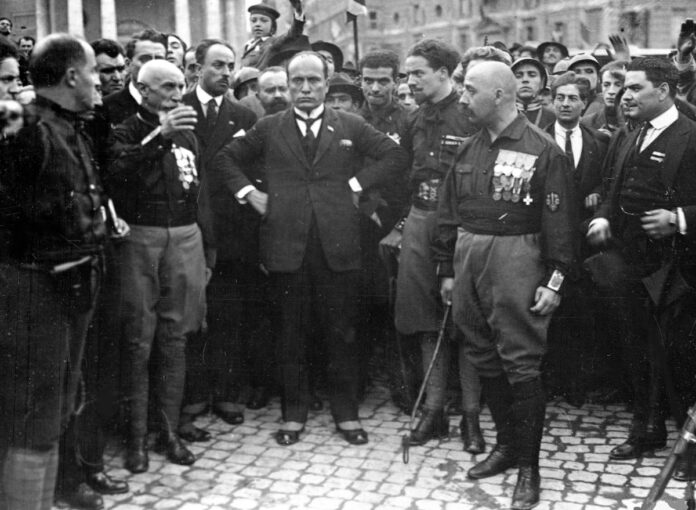Never has Italy’s failure to come to terms with its fascist past been more evident as it marks the 100th anniversary Friday of the March on Rome that brought totalitarian dictator Benito Mussolini to power, a date that has only gained more scrutiny as the first postwar government led by a neo-fascist party takes office.The symbolism looks troubling: Giorgia Meloni’s far-right Brothers of Italy party controversially retains the emblem of a flame used by the fascists; her party’s co-founder, Ignazio La Russa, whose middle name is Benito and whose home office is awash in fascist memorabilia, is the elected speaker of Parliament’s upper house.Meloni has tried to distance Brothers of Italy from its neo-fascist roots. She made her clearest statement yet this week during a speech to Italy’s lower house ahead of confidence votes confirming her government.’I have never felt sympathy or closeness to undemocratic regimes, fascism included, as I have always considered the racial laws of 1938 the lowest point in Italian history, a shame that will mark our people forever,” Meloni told the lower house of parliament Wednesday, decrying Mussolini’s laws that persecuted Italy’s Jewish community.The question remains, however, whether the moderate voice she has recently adopted will persevere, and how that will be tolerated by the nostalgic wing in her party that represents a core 4% of her support.Already, the National Association of Italian Partisans, or ANPI, which preserves the memory of the wartime resistance against fascism, has noted some signs of an emboldened far-right in regions governed by the Brothers of Italy. For example, the governor of the central Marche region has cut off funding to maintain brass-plated Stumbling Stones engraved with the names and dates of Holocaust victims outside their prewar homes, ANPI national president Gianfranco Pagliarulo said. He added that social media attacks against his organization have grown more virulent than ever. ‘This is a disturbing signal,” Pagliarulo said. ‘It is evident that the victory of the nationalist right will lead to a resurgence of neo-fascist provocative attitudes … We are not worried because we will fight with political weapons, and if necessary, with legal weapons.’On Friday, ANPI will hold a demonstration in the northern town of Predappio, where Mussolini is buried, to mark the town’s liberation from fascism on Oct. 28, 1944. The date was deliberately chosen by the partisan liberators to eclipse the memory of the March on Rome.It conveniently also prevents fascist nostalgics from commemorating the March on Rome that day. Their event is scheduled for Sunday, the final day of Mussolini’s historic March on Rome, and one of three commemorations held by neo-fascists in Predappio each year. The others mark the day of Mussolini’s birth, July 29, 1883, in a house not far from the cemetery with his crypt, and April 28, 1944, the day he was killed by partisans in Milan.’The March on Rome is the founding myth of fascist Italy, and for us it is a negative myth, as the origin of a disaster that led Italy into many wars, most catastrophically World War II,” Pagliarulo said. ‘We must combat the positive myth of the March on Rome and sustain this day as the start of the darkest period in modern Italian history.’Italy never went through a process similar to Germany’s de-Nazification, and a neo-fascist party, the Italian Social Movement, was part of Italy’s first postwar government in 1946. The fascist legacy endures in architecture throughout the country, from school buildings in small towns to Milan’s stately train station and massive courthouse and Rome’s EUR district. Popular notions persist that Italy’s two decades of fascism brought progress, exemplified by the era’s timely train services, architectural boom and the draining of malaria-infested swamps.It is still possible – though far from common – to spy a portrait of Mussolini hanging behind a bar or in a restaurant, in particular in Italy’s productive northern regions, or to come across fascist memorabilia or souvenirs in otherwise ordinary shops. Though the partisan association views such displays as an apology for fascism, punishable by law, they are rarely, if ever, prosecuted. ‘Historians rightly teach us that fascism ended in Italy in ’45. But not the fascists,” said historian Francesco Filippi, who has written a book analyzing popular misconceptions about fascism. ‘Millions of people who took part in that regime and continued to be part of the political life of the country, and even parties that directly referred to fascism, took part in the political life of the country from 1946, arriving to the present day very continuously.’Filippi said the moderate voters who boosted Meloni from 4% of the vote in 2018 to 26% in September’s parliamentary elections indicated a fundamental expansion in the party’s base beyond those “who recognized the Brothers of Italy as the historical heir of the Italian Social Movement, and therefore a certain type of fascist idea.’ Many of the new voters, he said, hope Meloni will construct a conservative right-wing government, “a normal right-wing, that is anti-fascist, tied to democratic values.’The standard bearers of Italy’s wartime partisan movement said they are withholding judgment on Meloni’s government until it takes concrete actions.’We hope that it becomes a right-wing conservative government, like in France or Britain,” said Miro Gori, the ANPI president in the Emilia Romagna province where Predappio is located. ‘We will see what happens.’___Paolo Santalucia contributed from Rome.


